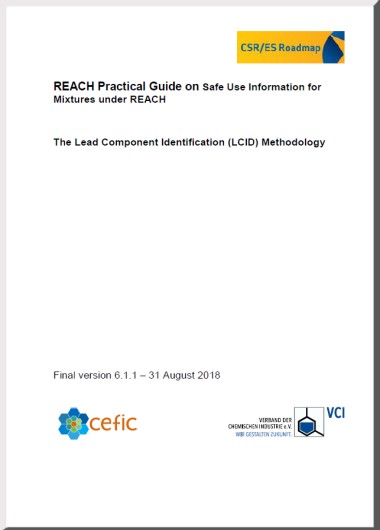Downloads
-
Brief description of the "REACH Practical Guide" of VCI and Cefic regarding the safe use of mixtures under REACH and LCID method
PDF | 217 kB | Version as of: 16 March 2016 -
Cefic/VCI Lead Component Identification Tool: LCID Calculation Sheet Version 1.0 (Excel file)
XLSM | 2 MB | Version as of: 12 July 2016
As most substances are used in producing mixtures, formulators need a way to apply the component Exposure Scenario (ES) information received from their suppliers and to derive safe use information for their mixtures. For this purpose a Cefic/VCI Task Force has elaborated the ,Lead Component Identification Methodology' (LCID) and issued a practical guide on the topic in the year 2018. In August 2018, a corrigendum has been finalized.
- Publication
- 117 Pages / DIN A4
- Target group
- VCI member companies; producers of mixtures / formulators; downstream users

The European Chemical Industry Council (Cefic) and VCI have jointly issued the "REACH Practical Guide on Safe Use Information for Mixtures under REACH - The Lead Component Identification (LCID) Methodology". The project is a contribution to the CSR/ES Roadmap ("Chemical Safety Report/Exposure Scenario"), a joint action plan of authorities and industry regarding exposure seenarios and communication on safe use conditions of chemicals in the supply chains.
At the time being, Cefic and VCI are elaborating examples showing how the resulting information can communicated in the safety data sheet or its annex. This takes place within the frame of action 4.2 within the ENES working programme ("Exchange Network on Exposure Scenarios" - the succeeding actitvity to the CSR/ES Roadmap). A report is planned for 2019.
Background
Under the Chemicals Regulation REACH (EC) No. 1907/2006, the concept of an Exposure Scenario (ES) was introduced as a new element of a chemical safety assessment (CSA). An ES was identified as the means to communicate the safe use conditions of a substance to Downstream Users (DUs) along its various supply chains.
As most substances are usually used in producing mixtures, formulators need a way to apply the component ES information received from their suppliers and to derive safe use information for their mixtures – with the idea that this information be communicated to further DUs via Safety Data Sheets (SDSs).
Under the joint CSR/ES Roadmap of authorities and industry (Chemical Safety Report/Exposure Scenario), a Task Force composed of Cefic (European Chemical Industry Council) and VCI (German Chemical Industry Association) representatives committed to developing a logical and technically defensible methodology, based on their previous experiences. This led to the creation of the Lead Component IDentification methodology “LCID” (Roadmap Action 4.4A on mixtures) that is presented here.
The underlying principle of the LCID methodology is that if the risks are controlled for the most hazardous component(s), then the risks from the other substances in the mixture are also likely to be controlled. The methodology relies on concentrations of the components, the DNELs and PNECs available from REACH registrations and the classification of the components of the mixtures as communicated via extended SDSs.
The LCID methodology takes into account the following cases, addressing both human health and environmental hazards:
- Priority substances: Carcinogens and mutagens (CLP Categories 1A, 1B and 2) that are non-threshold substances, and PBTs/vPvBs
- Classified substances with DNELs and PNECs
- Classified substances which lack DNELs or PNECs but have available other toxicity reference values or classifications (e.g., NO(A)EL, LD50 value, M-factor)
- Additive effects of substances that have similar modes of action and similar biological effect
- Substances with local effects (e.g. eye, skin, respiratory tract irritation/corrosivity and sensitisation)
- Biodegradability, ozone depleting potential
- Specific conditions affecting exposure
The Practical Guide
A practical guide was elaborated, outlining the LCID methodology. Chapters 1 to 6 introduce the topic and the concrete tasks that formulators need to carry out to derive safe use information for their mixtures. Chapter 7 explains how to identify lead components and includes a detailed workflow and descriptions of all steps, considerations and calculations to be performed. Test examples are provided in Annex III to demonstrate how the methodology can be applied in practice. Annex IV includes the technical rationale for decisions taken in this approach. A supplementary Excel-based tool was prepared to partially automate the methodology.
The development of the LCID methodology was accompanied by consultations, inter alia, with experts on exposure scenarios (ENES platform). The methodology and the tool were successfully tested by a cross-stakeholder group to confirm its comprehension and reproducibility.
The Cefic/VCI Mixtures Task Force in charge of the project would like to express its gratitude to the numerous individuals, companies and organisations that contributed, inter alia, with their fruitful discussions, comments on draft versions and participation in a test-run. They helped shape and add robustness to this methodology.
The practical guide is available as a PDF file in English language and comprises 178 pages. Additionally, the brief description of the publication as given earlier on this page can be downloaded as a PDF file in the section "Ergänzende Downloads" at the top of this page.
Moreover, an excel template for performing calculations according to the LCID method is also available in the section "Ergänzende Downloads". Please consider the conditions of use included in the “Disclaimer” tab and the “Short instructions” in the respective tab.
Table of Contents
- Introduction
- Supply chains and mixtures
- REACH obligations for actors dealing with substances in mixtures and mixtures themselves
- REACH and formulators
- Tasks for formulators under REACH
- Obligations for formulators under REACH
- Tips to cope easier with the obligations under REACH
- Information to be given by formulators for the risk assessment of substancesin mixtures
- Safe use information for mixtures
- Options for including safe use information in a safety data sheet
- Approaches for developing safe use information for mixtures
- Determining safe use information for inclusion in a safety data sheet of a mixture
- The process and its main steps
- Approach for mixtures as a “raw material” for other mixtures
- Identification of Lead Components
- Introduction
- LCID methodology - Human Health hazards
- LCID methodology - Environmental hazards
- Extended evaluation of mixtures
- Interactions between substances of a mixture
- Generation of suitable safe use information – additional options for DUs
- IT support for the compiling of safety data sheets for mixtures
- Glossary
Annex I: Concentrations limits for substances in mixtures according to REACH Art.
Annex II: Integration of information from an exposure scenario in the main body of a safety data sheet
Annex III: Test examples applying the Lead Component Identification (LCID) methodology
Annex IV: LCID methodology – Underlying principles and rationales
Conditions of use and disclaimer
This Practical Guide has been created by Cefic (The European Chemical Industry Council) and VCI (Verband der Chemischen Industrie e.V.), January 2016, amended in August 2018.
Copying is authorised, except for commercial purposes, provided that the source is mentioned and acknowledged.
The content of this guide is based on the understanding of the situation as of today and updates may be required in the future.
Each party may decide to use or not this guide based upon its own decision-making criteria. Whilst the information is provided in utmost good faith and has been based on the best information currently available, it is to be relied upon at the user’s own risk. No representations or warranties are made with regards to its completeness or accuracy and no liability will be accepted by anyone having prepared this guide, including Cefic, VCI and its members, for damages of any nature whatsoever resulting from the use of or reliance on the information.
This does not apply if damage was caused intentionally or by gross negligence by Cefic or VCI or by parties assisting them or in case of bodily harm and damage caused to health or life.
More information
Information on the CSR/ES Roadmap on the website of ECHA
Contact
For questions or suggestions, please feel free to contact us.

Dr. Angelika Hanschmidt
Europäische Chemikalienpolitik, EU-Chemikalienstrategie, REACH
- E-mail: hanschmidt@vci.de
